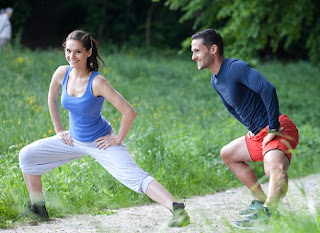Both static and dynamic stretching exercises are known to greatly assist in reducing the chance of serious injury before doing a workout or playing sports, but are they really necessary to maximize performance?
In fact, can we question why the warm-up is really required at all, and if it is, what are the aspects to look at when completing the warm-up regime?
So really, what does a warm-up actually do for a person?
Well, engaging in a warm-up routine does just what it says it will - it warms your body, joints, ligaments, tendons and muscles in preparation for a sporting or exercise activity. And if you think about this, it also helps with anti-ageing.
You can argue that increasing the body's internal temperature should be good enough to play sports or exercise safely, but this is not necessarily effective as preparation for any intense physical behaviour. By completing warm-up exercises you will be increasing the temperature of your muscles and loosening them which in turn increases flexibility.
The loosening of the body's muscles and dilation of the blood vessels contributes to a greater amount of blood flow throughout your body. This assists in oxygenating the muscles and removal of damaging waste products.
Upon completing these warm-ups you will notice that you are more supple, flexible and show a reduced level of stiffness. This lowers your resistance to certain sporting movements and lowers the chance of injury, specifically muscle tearing.
Further advantages of good warm-ups include an elevated heart rate, strengthened respiratory capacity and positive metabolic level. You will also notice that the nutrients delivered to your muscles assist in lubrication of your joints and prepare you for future work-out sessions.
This increases your resilience and resistance to any cartilage tearing and associated injuries.
Irrespective of the type of sport you will be playing, having a healthy and fit cardiovascular system is essential to your performance; as is flexible joints and muscles to a lower risk of potentially irreparable injury. By completing a 10 to 15 minute warm-up session, that includes both dynamic and static stretching exercises, you can ensure a safer and stronger sporting experience.
There are various types of stretching exercises that can be completed and it is recommended that the area of your focus be specific to the sport you will be playing.
For example, if you are planning on jogging a long distance then you should warm up with a brisk walk; however, if you are planning on playing tennis or golf, you should complete a warm-up activity focusing on low-impact swings.
As the warm-up regime continues so will the speed and intensity of the movements.
This helps you prepare physically for your sporting activity, particularly with regards to your cardio and lung system. It will also prepare you mentally for any high performance activities.
As with any high-impact activity, it is important that you do not push yourself to the point of injury. The idea of a warm-up is to prepare the body for activities, not to perform one.
Author John Falkinder is the Founder of SteamTrainFitness and specializes in Active Ageing for life-long fitness. Find out more about anti-ageing, fitness for the long haul and the benefits of a few simple lifestyle changes that will add more life to your years.
Article Source: http://EzineArticles.com/expert/John_Falkinder/63092

Blogger Comment
Facebook Comment